
Keke Kaikhosroshvili
Keke is Zavvy's expert in learning experience. On our blog, she shares experience and insights based on her studies in learning design and experiences made with our customers.

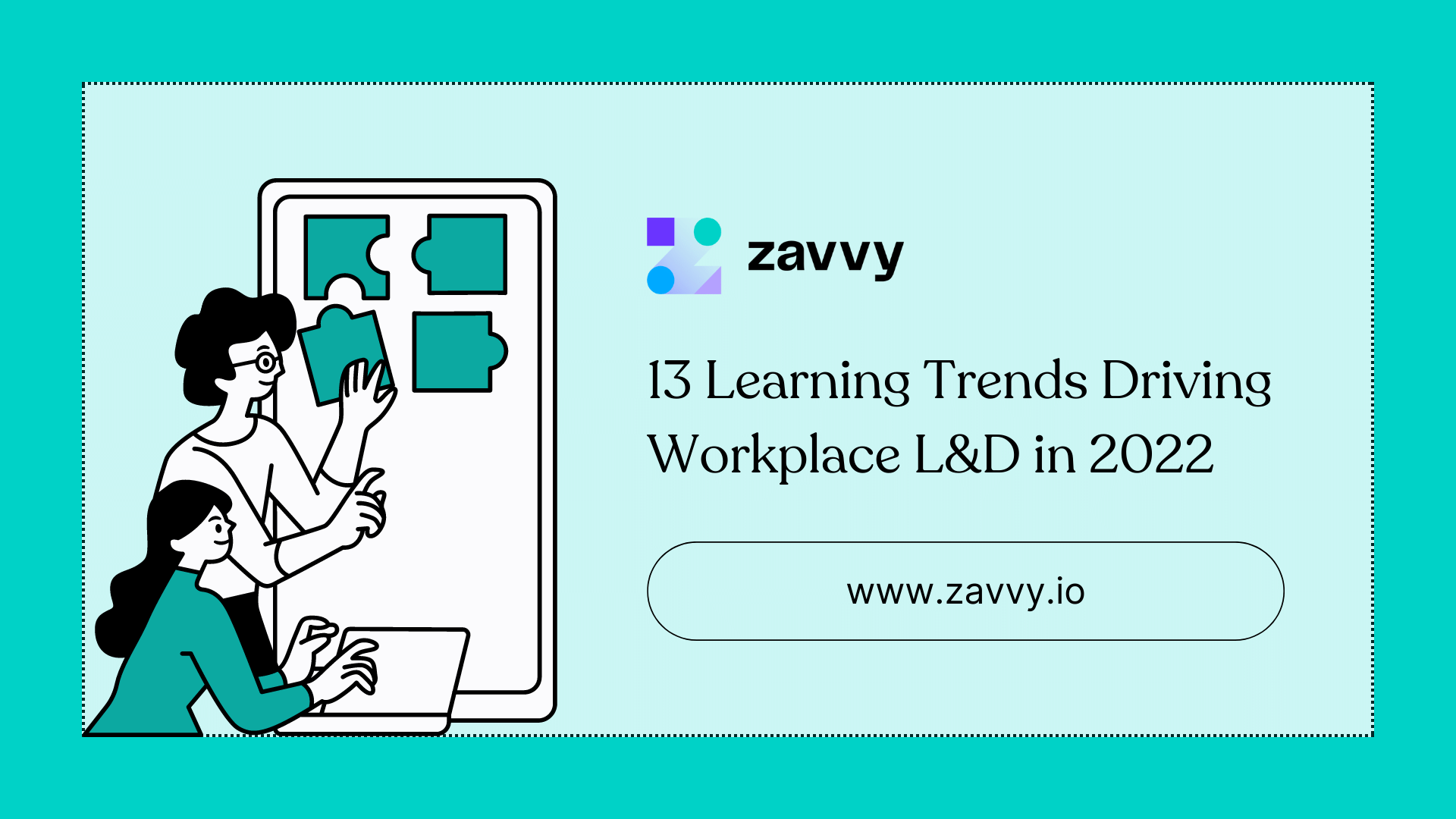
The shifting talent landscape has created a massive demand for reskilling and upskilling. 87% of current organizations have skills gaps they hope to fill by L&D investments in these areas, according to McKinsey.
But "learning and development" is a broad topic.
So, how do companies find the right growth strategies that allow their employees to progress quickly without negatively impacting daily operations?
Remote training has been one of the top trends in online learning since the start of the pandemic, but it's not entirely plain sailing. Digital training is forecast to live on, but connectivity issues, digital fatigue, and muted microphones are common problems faced in the virtual classroom.
Add work-related stress into the mix, and there are still many barriers to overcome in L&D adoption, even with 57% of companies upping their commitment.
So, what are some of the most popular corporate trends in learning and development, and how do they overcome current challenges? Here are 13 dominating the market this year.
"As we are recovering from the wrath of the pandemic and many people are returning to work, it's important to be aware of the latest learning and development trends. With staff working virtually and often globally, workplace training will need to adapt."
- Claire Rookes, Operations Director at Aspire Europe
Offices are reopening and companies have a decision to make. Will they revert to in-person training from a classroom or continue with digital learning? A study from the Dresden University of Technology suggests that blended learning (a mix of eLearning and in-person teaching) is the most likely.
Researcher Dr. Anne Gärtner explains, "Digital teaching should be seen as a complementary means to further improve the quality of teaching, and the importance of face-to-face teaching should not be forgotten. The flexibility in terms of time and space in work organization is one of the greatest advantages of digital teaching, as not only time but also costs can be saved, for example, by eliminating travel."
Bear in mind: Knowledge retention rates for classroom-based training are just 8 to 10% vs. 25 to 60% for digital training.
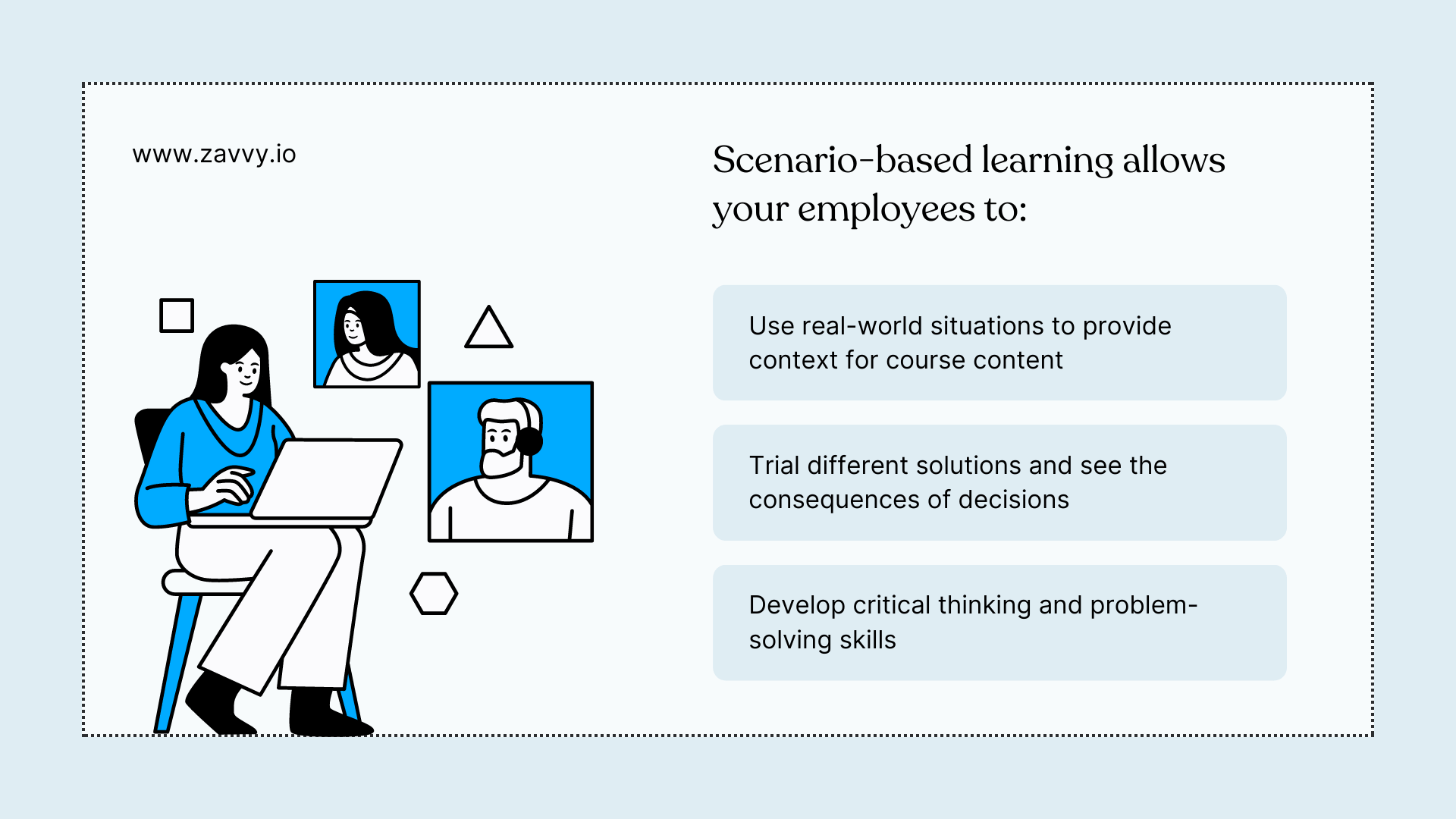
Scenario-based learning is an educational technique that uses real-world situations to provide context for course content. Traditionally used in military and medical training, scenario-based training is also gaining pace as a corporate learning and development trend.
SBL is based on the situated learning theory formulated by Lave & Wenger in 1991. One of its advantages is that it allows employees to test things out on the job and in a safe environment. They can also try different solutions and see the consequences of decisions without real-world repercussions. This type of learning is excellent for developing critical thinking and problem-solving skills.
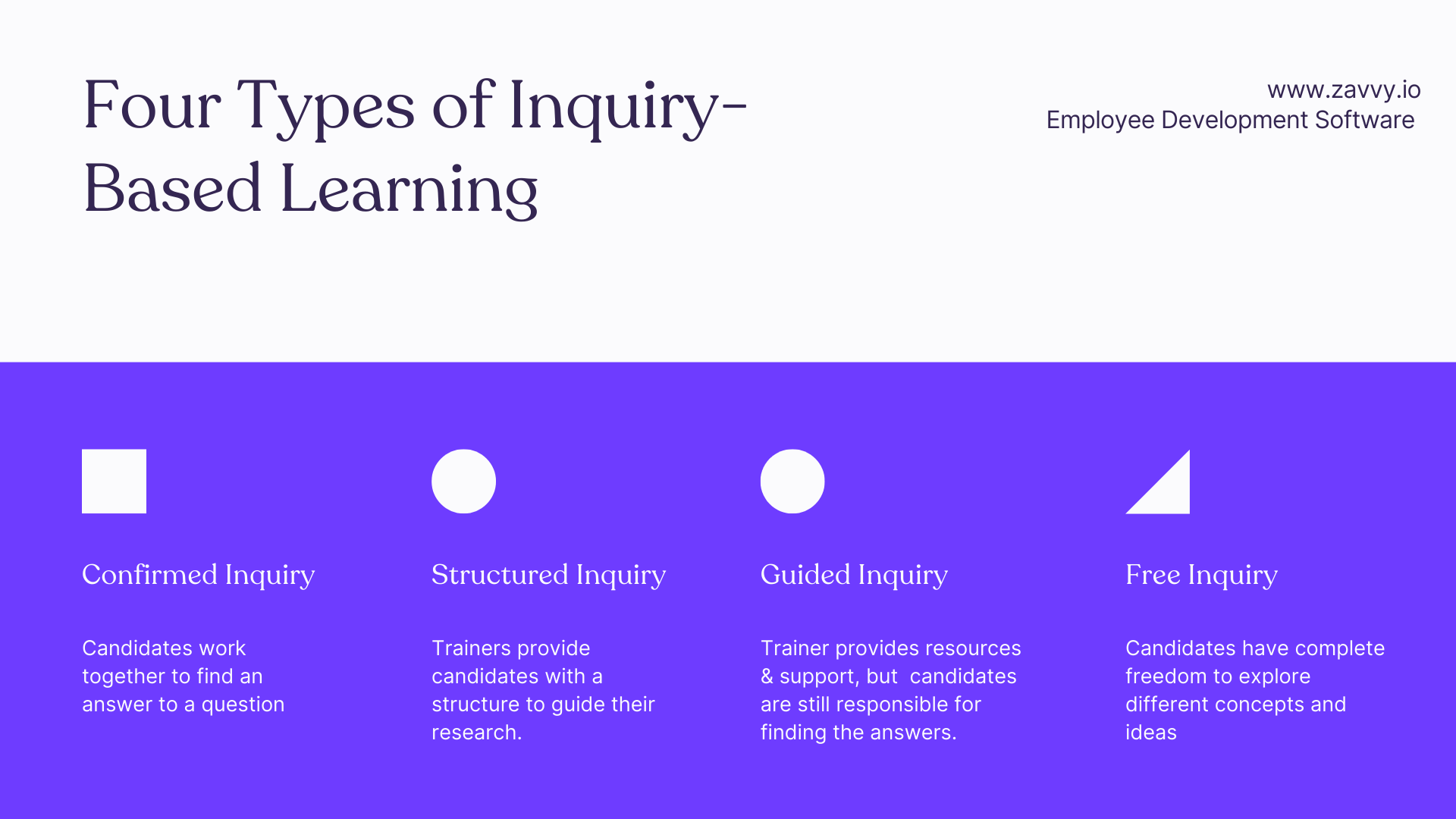
Inquiry-based learning is a student-centered approach that encourages learners to explore different concepts and find their own answers. It's beneficial because it allows students to take control of their education. They're also more likely to remember the information they've discovered themselves.
Real-life example: take Google, which famously uses "20% time" to encourage employees to engage in self-directed projects like creating AdSense and Google News. These have been successful thanks to Google employees feeling passionate, intrigued, and intrinsically motivated by their own choice of projects. And this forms the foundations of inquiry-based learning.
Here are four types of IBL:
Dynamic training is an approach that's constantly evolving. Programs are regularly updated to keep up with the latest industry changes. They're also tailored to the needs of each learner, as opposed to being one-size-fits-all.
Static or stability training, on the other hand, is focused on maintaining the status quo. L&D professionals design programs to keep employees up-to-date with the skills they need for their current job. They're not focused on future-proofing or developing new skills.
The advantages of dynamic training are that it's more responsive to change and can be tailored to individual needs. Static training may appear more cost-effective and easier to implement in the short term, but is less effective over the long term.
Albert Bandura established the theory of social learning based on 4 underlying principles:
Although Bandura's theory was developed in the 1970s, social learning also has many applications in the modern workplace. For example, companies use it to:
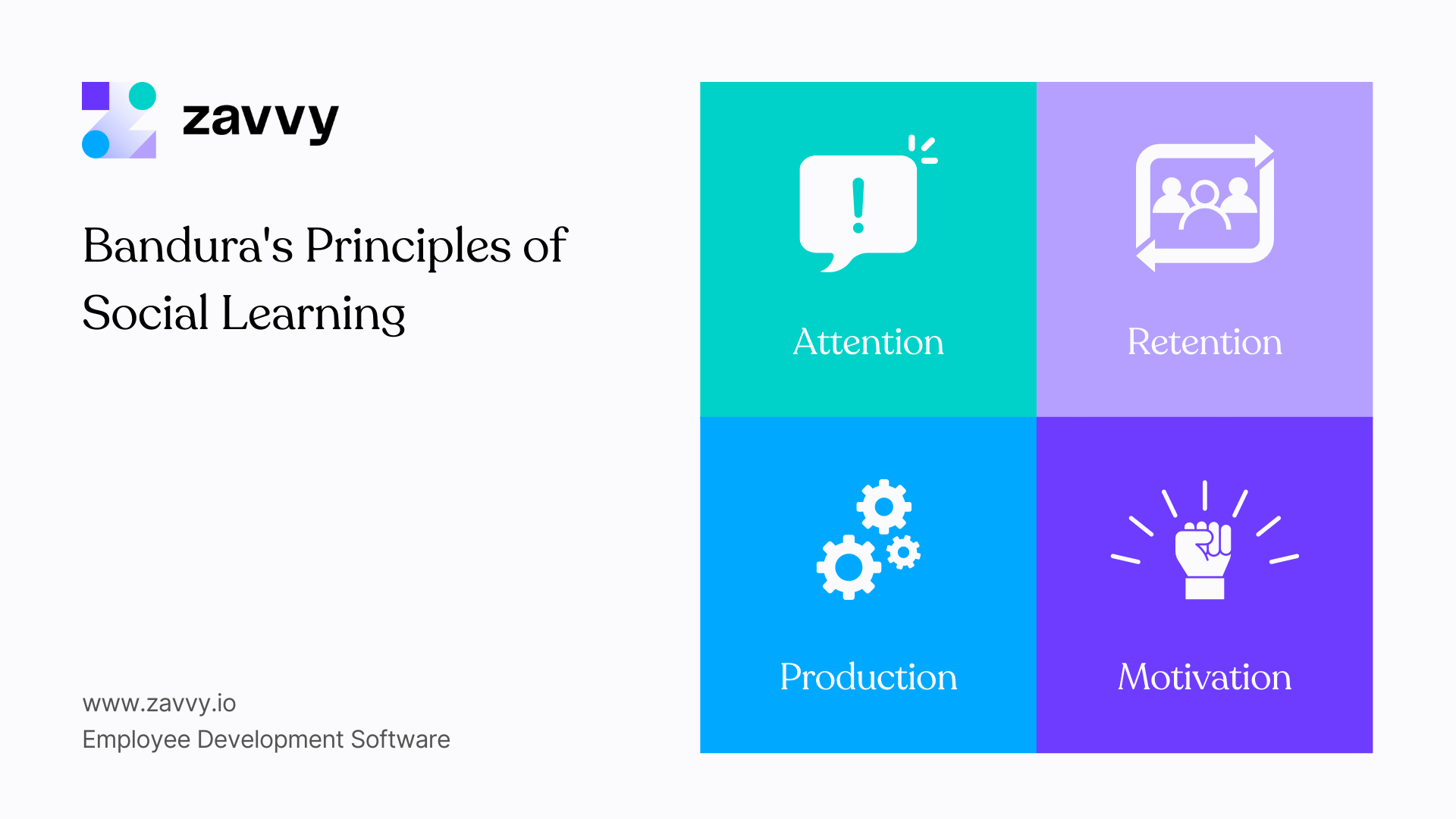
The primacy effect is the tendency for people to remember information that comes first better than information that comes later. In traditional training, this explains why lengthy corporate courses don't work. Course attendees remember the beginning and the end, but the information in the middle will be lost.
Microlearning is a solution to this problem. It's a type of learning delivered in short, bite-sized sessions of 5 to 15 minutes. As they're easier to digest, learners are more likely to retain the info. Microunits are usually self-paced and can be accessed on-demand from various learning platforms across mobile devices, laptops, and tablets.

Artificial intelligence can customize online learning, meaning students receive precisely the learning content they need. Companies like Freeletics push notifications out to Slack and Teams, where learners are already spending their time, so there's no extra effort to get involved.
Read next: How Freeletics combines modern training formats to develop their leaders
Gamification is the use of game elements in non-game contexts to engage, motivate and teach. As an effective way to make learning fun and interactive, this isn't a trend that's going away. Use it in a wide variety of topics, from teaching soft skills and health and safety to financial literacy and cybersecurity.
Learners engage with characters but also with the competitive element offered by gamification, and enjoy receiving certifications for course completion. They also want to know how they compare to their peers!
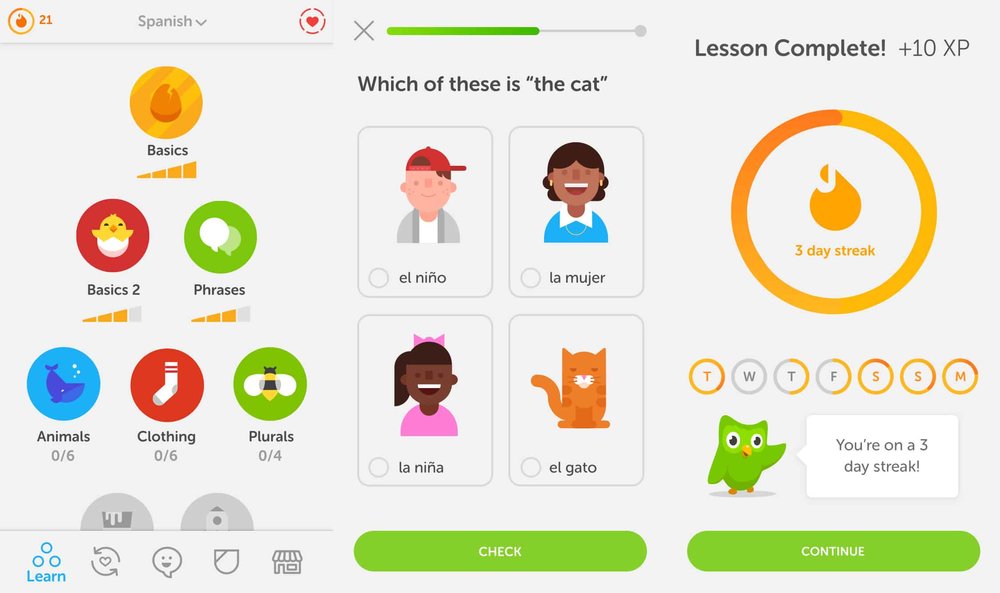
Deloitte uses gamification in its leadership academy training program, with elements like badges and status symbols which are highly popular. Many trainees describe the platform as "addictive", resulting in a 47% increase in learners using it daily.
Video is a red-hot trend in learning and development, just as it is in the marketing world. And it's easy to see why – 65% of people are visual learners, and 83% find it easier to recall info delivered by video rather than text.
Video training is also cost-effective. Trainers can use the same video in different online courses or recycle sections for new courses, meaning there's less need to create fresh content from scratch each time.
Resources like Loom or YouTube allow you to create a relevant library of video training materials that employees can access anytime, from anywhere. These platforms also encourage learners to interact by adding comments and emojis alongside the video, which are valuable insights for L&D leaders.
One-size-fits-all learning management systems rarely fulfill an organization's entire training needs. So instead, companies are creating their own "knowledge-sharing ecosystems" that allow employees to easily find and share the resources they need.
This is a more customized approach, choosing the exact applications and training materials needed to engage their workforce.
"We're trying to empower employees so they can share their knowledge and bring value from that for the company. The individual is empowered, and they can seek their own growth and knowledge-sharing."
- Kim Glover, Director of Knowledge Management & Social Learning, Technip FMC
Accessibility is a priority for learning leaders as organizations improve their DEI efforts. Many companies are now offering more flexible access options for remote learners, such as closed captioning and sign language interpretation for videos, transcripts of audio recordings, and Braille or large print versions of text-based formats.
With 83.72% of the world's population now owning a smartphone, mobile learning is also an increasingly popular option for employees who want to learn on the go. The rise in remote working and the switch to microlearning means training providers must correctly optimize their content for mobile devices.
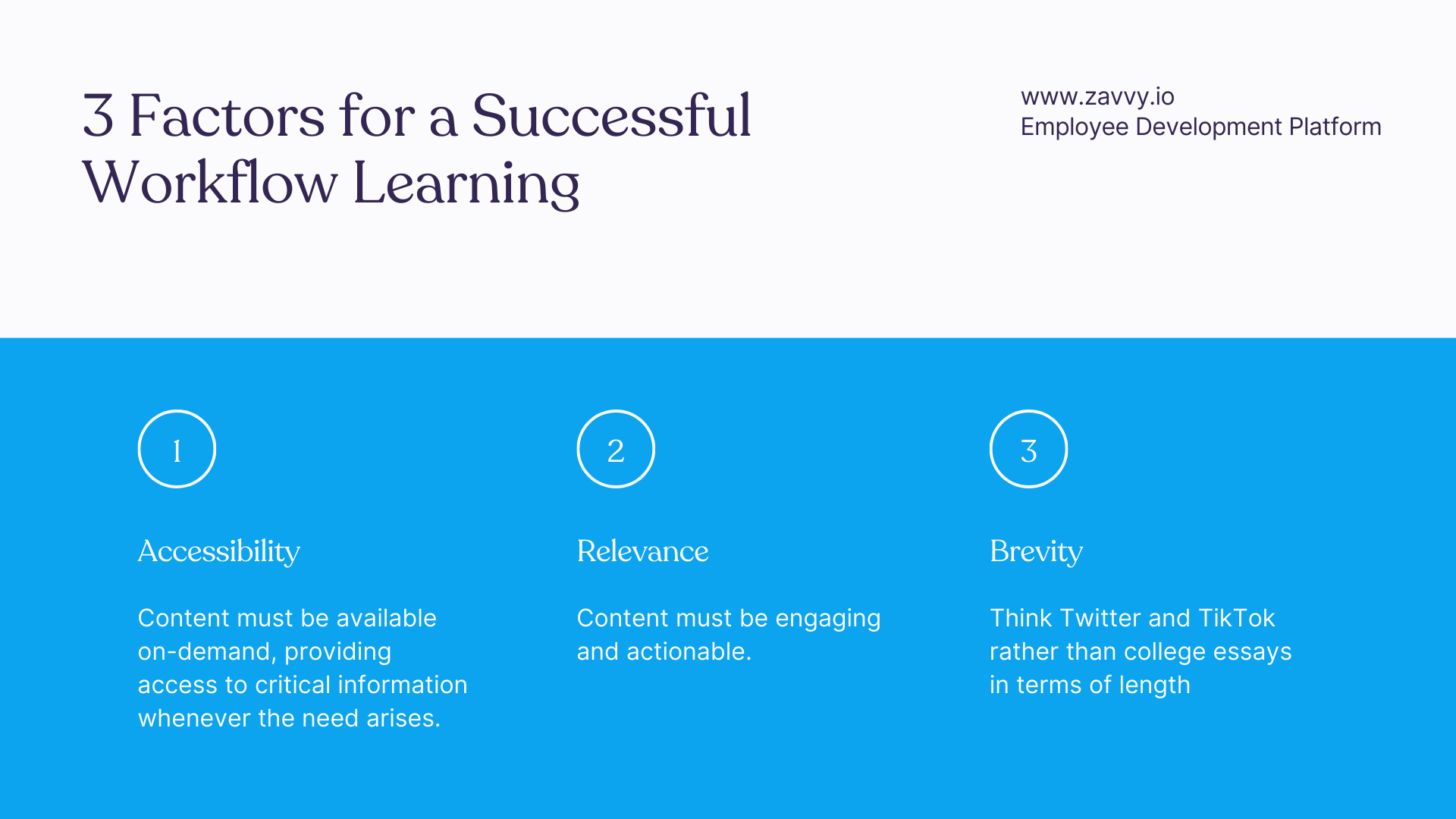
Workflow learning is a type of just-in-time learning that provides employees with the information they need when they need it. It's designed to help employees be more productive and efficient in their work.
This method of learning takes many different forms but is usually delivered in short, bite-sized pieces. This could be a tooltip, a popup quiz, or a short video. The important thing is that it's easy for employees to access and digest, integrating seamlessly with microlearning.
3 factors driving the success of workflow learning are:
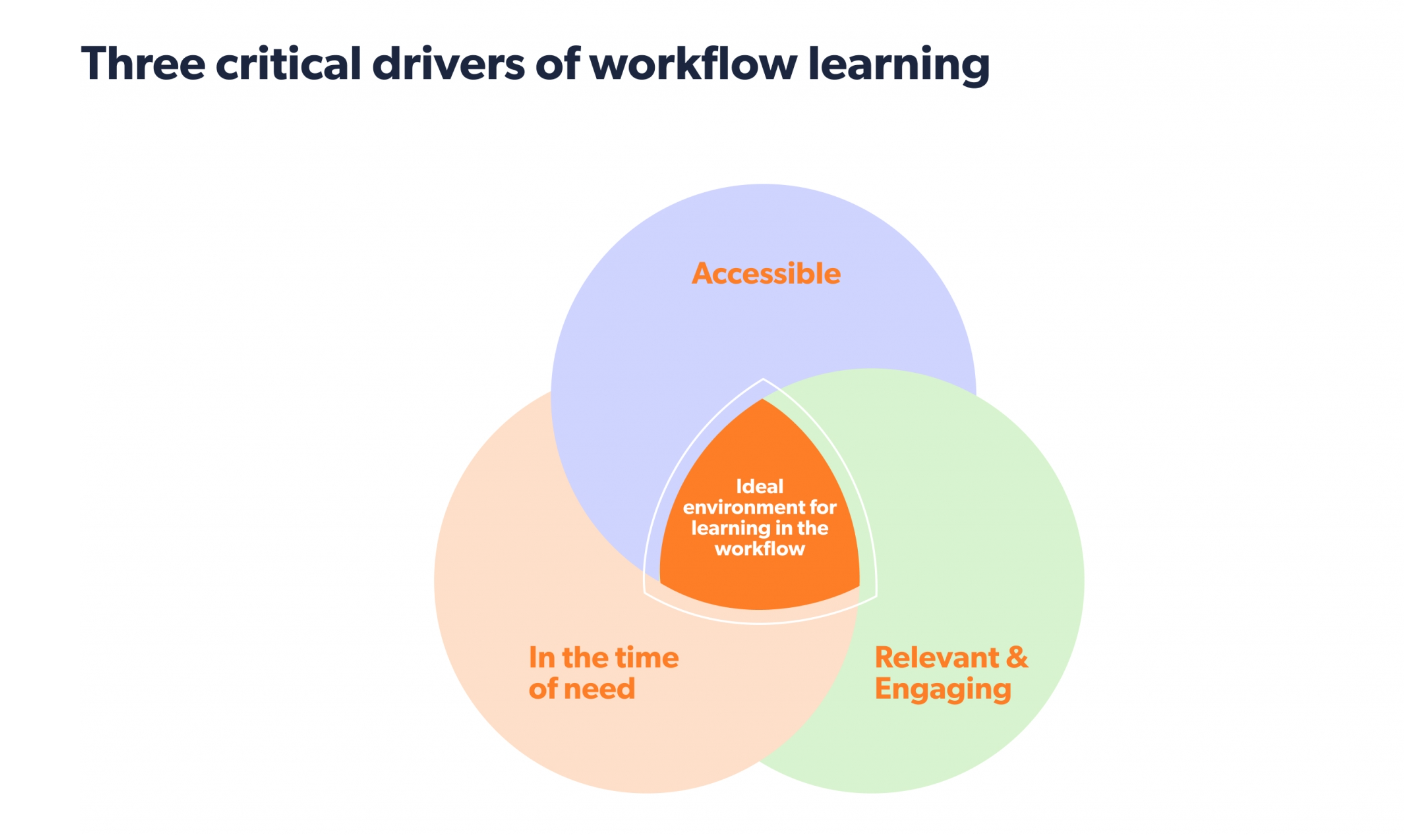
L&D teams are taking more notice of virtual reality training as it becomes more realistic. VR allows employees to experience simulations of work environments, which is helpful in safety training, sales training, and more. VR training is a highly immersive learning experience that can help employees retain information more effectively.
Another option is augmented reality (AR) which is similar to VR, but instead of creating a completely simulated environment, it overlays digital information in the real world. This can be in the form of text, images, or even 3D objects.
AR training is particularly useful for hands-on tasks that require employees to reference digital instructions while they work. For example, an engineer might use AR glasses to view a digital blueprint while assembling a machine. AR has also been used in sales training to give employees a realistic view of the products they're selling. This can be helpful for complex products that are difficult to describe, such as software.
Here are some top examples of companies using immersive technologies in their training:
The Kurt Lewin change management model is a three-stage process that organizations can use to manage change effectively.
The idea is based on the idea of a block of ice, which can't be forced into a different shape without first changing states.
The model explains that change must be
So, how does this model apply to training? L&D departments must be able to embrace change if they want to keep up with the latest e-learning trends. This means being open to new ideas, trying new things, and constantly evolving. It can be a challenge, but it's essential if you want to stay ahead of the curve.
And the payoff? A more engaged, productive workforce equipped to meet the challenges of the future at a fraction of the cost of traditional training programs.
Are you looking to update your corporate training program? Your investment in L&D will go a long way by engaging your existing workforce and attracting new candidates to join your ranks.
Zavvy's training solutions are ideal from onboarding onwards to create a continuous learning culture for your company.
and more will be used in harmony with your employee development framework to maximize the growth of your workforce. Get in touch with our team of learning experts to arrange a demo.
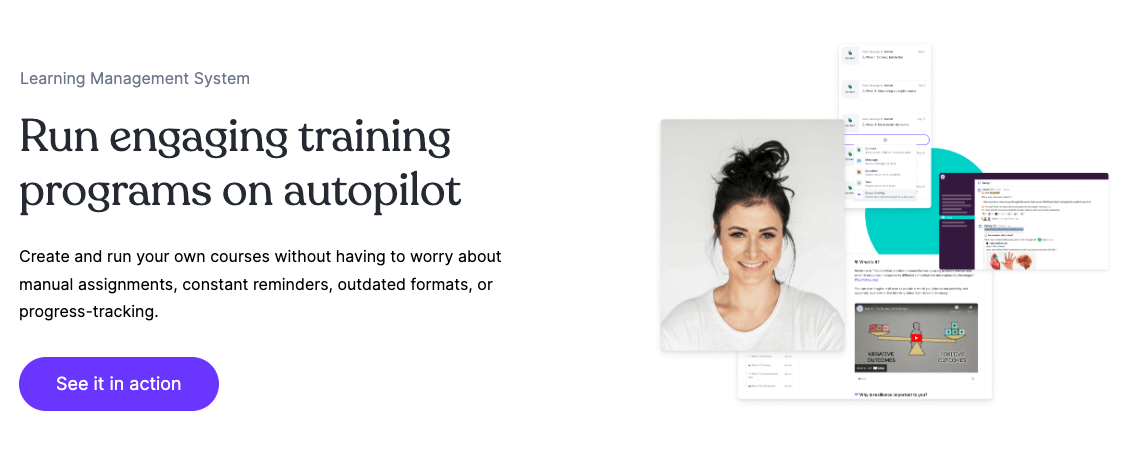
Together with our curators, we have created a library of actionable digital marketing resources. Personalized to your team's needs.
Upskill your team every week with the best contents and personalized recommendations.

The shifting talent landscape has created a massive demand for reskilling and upskilling. 87% of current organizations have skills gaps they hope to fill by L&D investments in these areas, according to McKinsey.
But "learning and development" is a broad topic.
So, how do companies find the right growth strategies that allow their employees to progress quickly without negatively impacting daily operations?
Remote training has been one of the top trends in online learning since the start of the pandemic, but it's not entirely plain sailing. Digital training is forecast to live on, but connectivity issues, digital fatigue, and muted microphones are common problems faced in the virtual classroom.
Add work-related stress into the mix, and there are still many barriers to overcome in L&D adoption, even with 57% of companies upping their commitment.
So, what are some of the most popular corporate trends in learning and development, and how do they overcome current challenges? Here are 13 dominating the market this year.
"As we are recovering from the wrath of the pandemic and many people are returning to work, it's important to be aware of the latest learning and development trends. With staff working virtually and often globally, workplace training will need to adapt."
- Claire Rookes, Operations Director at Aspire Europe
Offices are reopening and companies have a decision to make. Will they revert to in-person training from a classroom or continue with digital learning? A study from the Dresden University of Technology suggests that blended learning (a mix of eLearning and in-person teaching) is the most likely.
Researcher Dr. Anne Gärtner explains, "Digital teaching should be seen as a complementary means to further improve the quality of teaching, and the importance of face-to-face teaching should not be forgotten. The flexibility in terms of time and space in work organization is one of the greatest advantages of digital teaching, as not only time but also costs can be saved, for example, by eliminating travel."
Bear in mind: Knowledge retention rates for classroom-based training are just 8 to 10% vs. 25 to 60% for digital training.

Scenario-based learning is an educational technique that uses real-world situations to provide context for course content. Traditionally used in military and medical training, scenario-based training is also gaining pace as a corporate learning and development trend.
SBL is based on the situated learning theory formulated by Lave & Wenger in 1991. One of its advantages is that it allows employees to test things out on the job and in a safe environment. They can also try different solutions and see the consequences of decisions without real-world repercussions. This type of learning is excellent for developing critical thinking and problem-solving skills.

Inquiry-based learning is a student-centered approach that encourages learners to explore different concepts and find their own answers. It's beneficial because it allows students to take control of their education. They're also more likely to remember the information they've discovered themselves.
Real-life example: take Google, which famously uses "20% time" to encourage employees to engage in self-directed projects like creating AdSense and Google News. These have been successful thanks to Google employees feeling passionate, intrigued, and intrinsically motivated by their own choice of projects. And this forms the foundations of inquiry-based learning.
Here are four types of IBL:
Dynamic training is an approach that's constantly evolving. Programs are regularly updated to keep up with the latest industry changes. They're also tailored to the needs of each learner, as opposed to being one-size-fits-all.
Static or stability training, on the other hand, is focused on maintaining the status quo. L&D professionals design programs to keep employees up-to-date with the skills they need for their current job. They're not focused on future-proofing or developing new skills.
The advantages of dynamic training are that it's more responsive to change and can be tailored to individual needs. Static training may appear more cost-effective and easier to implement in the short term, but is less effective over the long term.
Albert Bandura established the theory of social learning based on 4 underlying principles:
Although Bandura's theory was developed in the 1970s, social learning also has many applications in the modern workplace. For example, companies use it to:

The primacy effect is the tendency for people to remember information that comes first better than information that comes later. In traditional training, this explains why lengthy corporate courses don't work. Course attendees remember the beginning and the end, but the information in the middle will be lost.
Microlearning is a solution to this problem. It's a type of learning delivered in short, bite-sized sessions of 5 to 15 minutes. As they're easier to digest, learners are more likely to retain the info. Microunits are usually self-paced and can be accessed on-demand from various learning platforms across mobile devices, laptops, and tablets.

Artificial intelligence can customize online learning, meaning students receive precisely the learning content they need. Companies like Freeletics push notifications out to Slack and Teams, where learners are already spending their time, so there's no extra effort to get involved.
Read next: How Freeletics combines modern training formats to develop their leaders
Gamification is the use of game elements in non-game contexts to engage, motivate and teach. As an effective way to make learning fun and interactive, this isn't a trend that's going away. Use it in a wide variety of topics, from teaching soft skills and health and safety to financial literacy and cybersecurity.
Learners engage with characters but also with the competitive element offered by gamification, and enjoy receiving certifications for course completion. They also want to know how they compare to their peers!

Deloitte uses gamification in its leadership academy training program, with elements like badges and status symbols which are highly popular. Many trainees describe the platform as "addictive", resulting in a 47% increase in learners using it daily.
Video is a red-hot trend in learning and development, just as it is in the marketing world. And it's easy to see why – 65% of people are visual learners, and 83% find it easier to recall info delivered by video rather than text.
Video training is also cost-effective. Trainers can use the same video in different online courses or recycle sections for new courses, meaning there's less need to create fresh content from scratch each time.
Resources like Loom or YouTube allow you to create a relevant library of video training materials that employees can access anytime, from anywhere. These platforms also encourage learners to interact by adding comments and emojis alongside the video, which are valuable insights for L&D leaders.
One-size-fits-all learning management systems rarely fulfill an organization's entire training needs. So instead, companies are creating their own "knowledge-sharing ecosystems" that allow employees to easily find and share the resources they need.
This is a more customized approach, choosing the exact applications and training materials needed to engage their workforce.
"We're trying to empower employees so they can share their knowledge and bring value from that for the company. The individual is empowered, and they can seek their own growth and knowledge-sharing."
- Kim Glover, Director of Knowledge Management & Social Learning, Technip FMC
Accessibility is a priority for learning leaders as organizations improve their DEI efforts. Many companies are now offering more flexible access options for remote learners, such as closed captioning and sign language interpretation for videos, transcripts of audio recordings, and Braille or large print versions of text-based formats.
With 83.72% of the world's population now owning a smartphone, mobile learning is also an increasingly popular option for employees who want to learn on the go. The rise in remote working and the switch to microlearning means training providers must correctly optimize their content for mobile devices.

Workflow learning is a type of just-in-time learning that provides employees with the information they need when they need it. It's designed to help employees be more productive and efficient in their work.
This method of learning takes many different forms but is usually delivered in short, bite-sized pieces. This could be a tooltip, a popup quiz, or a short video. The important thing is that it's easy for employees to access and digest, integrating seamlessly with microlearning.
3 factors driving the success of workflow learning are:

L&D teams are taking more notice of virtual reality training as it becomes more realistic. VR allows employees to experience simulations of work environments, which is helpful in safety training, sales training, and more. VR training is a highly immersive learning experience that can help employees retain information more effectively.
Another option is augmented reality (AR) which is similar to VR, but instead of creating a completely simulated environment, it overlays digital information in the real world. This can be in the form of text, images, or even 3D objects.
AR training is particularly useful for hands-on tasks that require employees to reference digital instructions while they work. For example, an engineer might use AR glasses to view a digital blueprint while assembling a machine. AR has also been used in sales training to give employees a realistic view of the products they're selling. This can be helpful for complex products that are difficult to describe, such as software.
Here are some top examples of companies using immersive technologies in their training:
The Kurt Lewin change management model is a three-stage process that organizations can use to manage change effectively.
The idea is based on the idea of a block of ice, which can't be forced into a different shape without first changing states.
The model explains that change must be
So, how does this model apply to training? L&D departments must be able to embrace change if they want to keep up with the latest e-learning trends. This means being open to new ideas, trying new things, and constantly evolving. It can be a challenge, but it's essential if you want to stay ahead of the curve.
And the payoff? A more engaged, productive workforce equipped to meet the challenges of the future at a fraction of the cost of traditional training programs.
Are you looking to update your corporate training program? Your investment in L&D will go a long way by engaging your existing workforce and attracting new candidates to join your ranks.
Zavvy's training solutions are ideal from onboarding onwards to create a continuous learning culture for your company.
and more will be used in harmony with your employee development framework to maximize the growth of your workforce. Get in touch with our team of learning experts to arrange a demo.

Get a demo!
We'll be happy to show you around and answer all your questions.
Trusted by innovative companies



We'll be happy to show you around, answer your questions, or arrange a free trial.
Erhalten Sie eine kostenlose Demo unserer Onboarding-Software.
Vertraut von



Your Training & Development Strategy - Solved in 1 Tool.
Trusted by innovative companies



We'll be happy to show you around, answer your questions, or arrange a free trial.
Learn how Zavvy helps you drive performance, development, and engagement.
Trusted by innovative companies



We'll be happy to show you around, answer your questions, or arrange a free trial.
We'll be happy to show you around and answer all your questions.
Trusted by innovative companies



We'll be happy to show you around, answer your questions, or arrange a free trial.
Gerne zeigen wir Ihnen ganz unverbindlich unsere Plattform im Detail.
Vertraut von modernen Unternehmen



Get a demo!
We'll be happy to show you around and answer all your questions.
Trusted by innovative companies



We'll be happy to show you around, answer your questions, or arrange a free trial.
Erhalten Sie eine kostenlose Demo unserer Software für Mitarbeiterenwicklung und Training.
Moderne Unternehmen
setzen auf Zavvy


